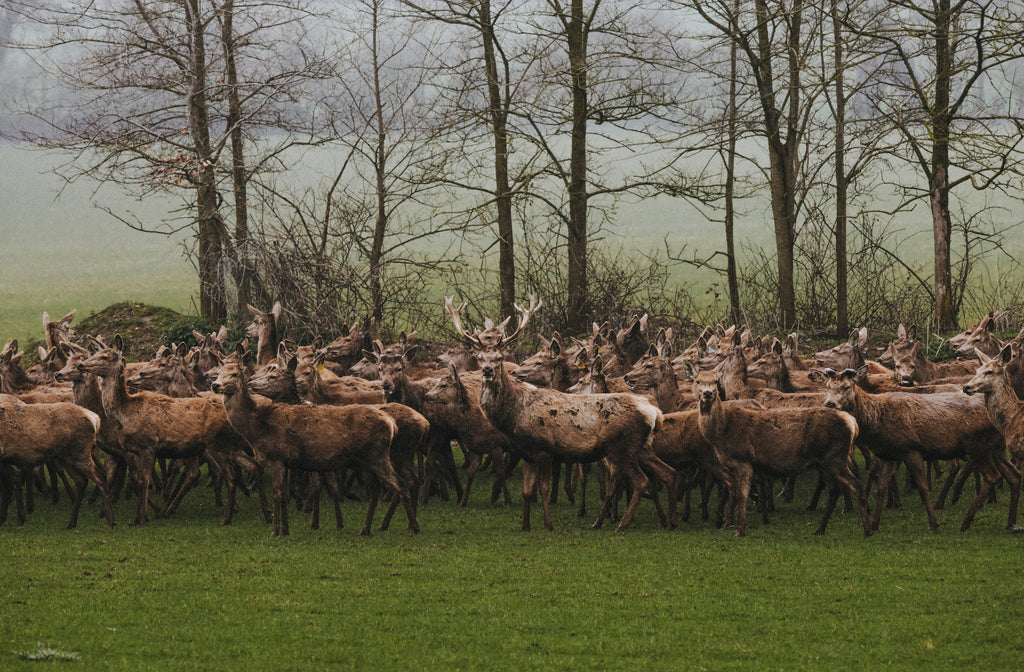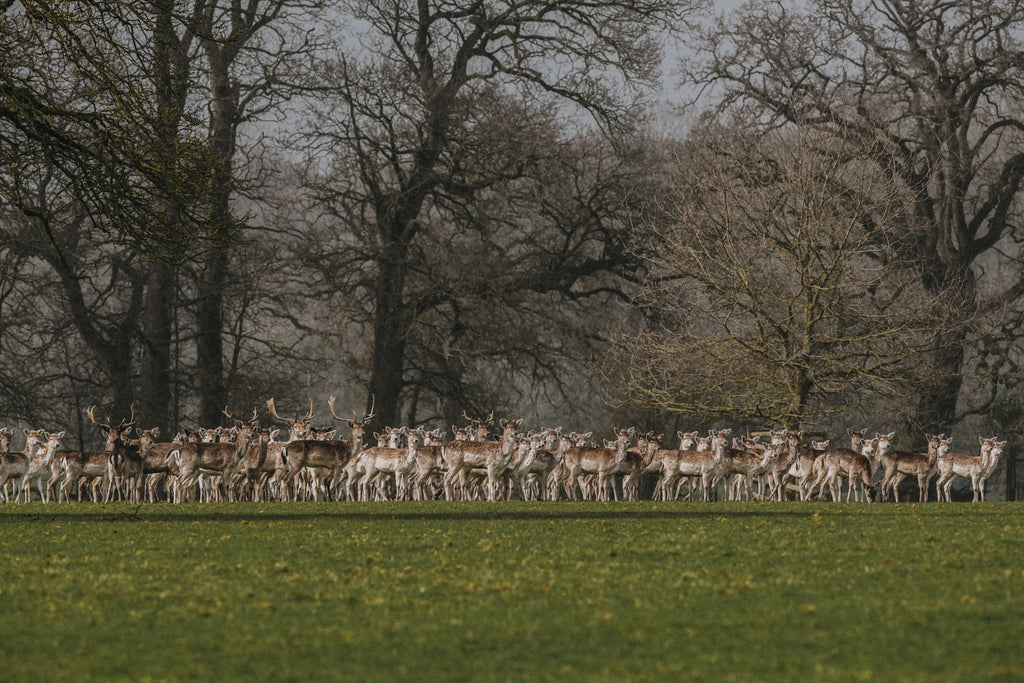
Our Wild Venison is usually in season from late September to early May.
Take a morning walk down a country lane and with a little observation, the chances are the land will tell you stories of the creatures you don't see. Thousands of wild venison cruise through our landscape each year, they offer an untapped, low-impact food resource that can reduce the environmental impact of our diets to a huge degree.
Let us tell you the story of our venison, and why it has been coined 'the most sustainable meat' to eat.

Breed
There are six species of deer living wild in the UK. While the lesser known species of sika, muntjac and Chinese water deer are less likely to end up on your plate, it’s important to consider how the breed affects the resulting meat - a rough rule of thumb is that the smaller the deer, the more delicate the texture of the meat.
At Pipers Farm, we utilise two breeds of venison that we find in abundance in the South West; Red Deer and Fallow Deer.
The largest native deer in the UK, red deer, live in large herds, happy either in woodland or open moorland. Due to their stature and the size of their herds, they can often be the most destructive of all the venison species.
The red deer carcass is large in comparison to other breeds. Red deer have a propensity to lay down fat, more so than other breeds, this makes the red suited for beautiful diced meat cut from the shoulder, or larger joints rolled from the haunch.
Fallow deer are medium in size, with fawn coloured coats flecked with white spots. Fallow herds are a common site in open land across the UK, especially here in the South West.
The meat from a fallow deer has a finer grained texture making it a favourite among many venison enthusiasts and perfect for cutting velvet textured steaks.

Natural Diet
A deers diet is wide and varied. As a ruminant animal, you'll only find deer grazing on vegetation, however they have a remarkably diverse diet. From pasture, to nuts, fruit and crops such as vegetables, wheat and barley (much to a farmers dismay). They will make use of mother's milk until naturally weaned and then they will be off, grazing on whatever comes their way.
This is one of the challenges with deer, they will eat everything in sight if they get a chance to. Springing over hedgerows and fences, they will much on vegetable and arable crops with relish. Unprotected young samplings trying to establish themselves in forests will be snipped off as a herd of deer makes their way through a woodland. Fallen acorns or chestnuts hoping to make their way into the soil to establish new trees, will be hoovered up.

Properly Wild
Our wild venison comes from vital conservation management of the South West countryside. All our wild venison is completely wild and free ranging and it is probably one of the most ethical and sustainable choices for your plate.
We work with highly skilled stalkers who carefully manage wild landscapes across Devon and Somerset, including Dartmoor and Exmoor, as well as farmland across the counties.
Our stalkers have an innate understanding of deer and their natural behaviours. Working at a distance it takes incredible skill for our stalkers to meticulously track each herd, monitoring the hiearacherachical social status as well as the health of each deer.
By choosing our wild venison you are directly supporting the careful management of our countryside, improving biodiversity of farmland and woodland habitats and protecting fledgling forests for future generations to enjoy.

Why is Venison so Sustainable?
Historically venison populations were managed by both human hand as well as apex predators such as wild cats, lynx and wolves. The natural cycle of predators moving into an area, would have pushed the herd on to find pastures new and meant less damage was occurring by large herds to one area.
Today, it is estimated that there is are over 2 million deer living in the UK, the highest number for 1,000 years. As the population has exploded and herds break off to form new hareems, they are increasingly causing accidents on roads.
One of the areas our stalkers now manage is a strip of land that runs parallel to A38, traditionally a notorious spot for deer caused road accidents. Since our stalkers have been managing this landscape, accidents in this area have been halved.
The huge increase of our venison population is raging havoc in our countryside too. The deers predilection for young plants and tree bark is having a significant impact on biodiversity, preventing the regeneration of woodlands and plant species.
Deer play an important role in encouraging species to flourish. As they move through landscapes they help to spread and tread in seeds. However, too many deer in one area, sadly has the opposite effect and ultimately leads to habitat degradation.
With the absence of apex predators, the only way to manage our ever expanding population of wild deer is through selective culling. However, sadly, much of the meat may end up in the finest restaurants, but is rarely seen on the plate of homes around the country on a regular basis.
There was a time in this country when venison meat was prized as the best meat in the land and enjoyed by kings and noblemen. It was hunted almost to extinction and as the species became more elusive, higher was the prize to take down a beast. The strong historical links between the wealthy of our nation and venison have often meant even today, it is seen as a ingredient that isn't for the everyday or for everyone.
We want to change all that. Without a doubt venison is one of the most ethical and sustainable sourced of high value protein that we can freely produce in the UK. Not only is it vital that we carefully manage our national population of deer to allow other species to thrive, it also happens to be incredibly nutrient dense and so good for you too. No longer is venison simply for noblemen or special occasions, we should be utilising this beautiful meat for everyday meals such as cottage pies, steak dinners, casseroles and even our beloved Sunday roast.

Traditionally Hung
Once our stalkers have selected an animal to be culled, they are cleanly shot out in the wild, providing a death that is ethical and significantly less stressful than taking an animal to slaughter.
We are passionate about producing the finest venison for your table and so, like every cut of meat we produce for you to enjoy, we take considerable time and care to mature our meat to perfection.
Our venison carcasses are hung in the fur for up to two weeks, before being skinned. We then hang the whole carcass for a further week to allow the meat to become even more tender and the beautiful flavour to be drawn out. Because of the skill from our marksmen and the meticulous way we handle the meat, you won't find the gamey flavour that is so often present in poorly prepared venison. Our venison should provide real pleasure and eating sensation and we often hear from our customers that it rivals our award winning Grass Fed Beef.
Buy Wild Venison
You can choose from a whole range of cuts of our Properly Wild Venison including; Venison Steaks, Venison Burgers, Diced Venison, Venison Mince and of course beautiful roasting joints of Venison.
We have a whole array of delicious seasonal recipes over on our journal to help inspire your cooking.
If you have any questions about or wild venison please do give our friendly customer care team a call on 01392 881 380 or send them and email to hello@pipersfarm.com.